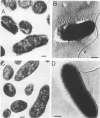Abstract
The adherence of radiolabeled Salmonella typhimurium to freshly isolated enterocytes of rats was studied. The results established that type 1 fimbriated strains adhered in significantly higher numbers than did related nonfimbriated strains. Adherence was inhibited by D-mannose and methyl alpha-D-mannoside. Results of kinetic studies indicated that adherence was biphasic; the number of bacteria that adhered per enterocyte remained constant for approximately 20 min and then increased rapidly under the assay conditions. The second phase was associated with structural damage to the enterocytes. The addition of chloramphenicol did not prevent the initial attachment of bacteria to enterocytes but did prevent the second phase. Viable and nonviable bacterial cells adhered to enterocytes, but only viable bacteria were destructive. Freshly isolated enterocytes (trypan blue impermeable) and enterocytes stored overnight (trypan blue permeable) were infected by viable S. typhimurium in a similar manner, suggesting that metabolic activity of the host cell was of less consequence than metabolic activity of the bacterial cells. A model for the role of mannose-sensitive fimbriae as a virulence factor is proposed.
Full text
PDF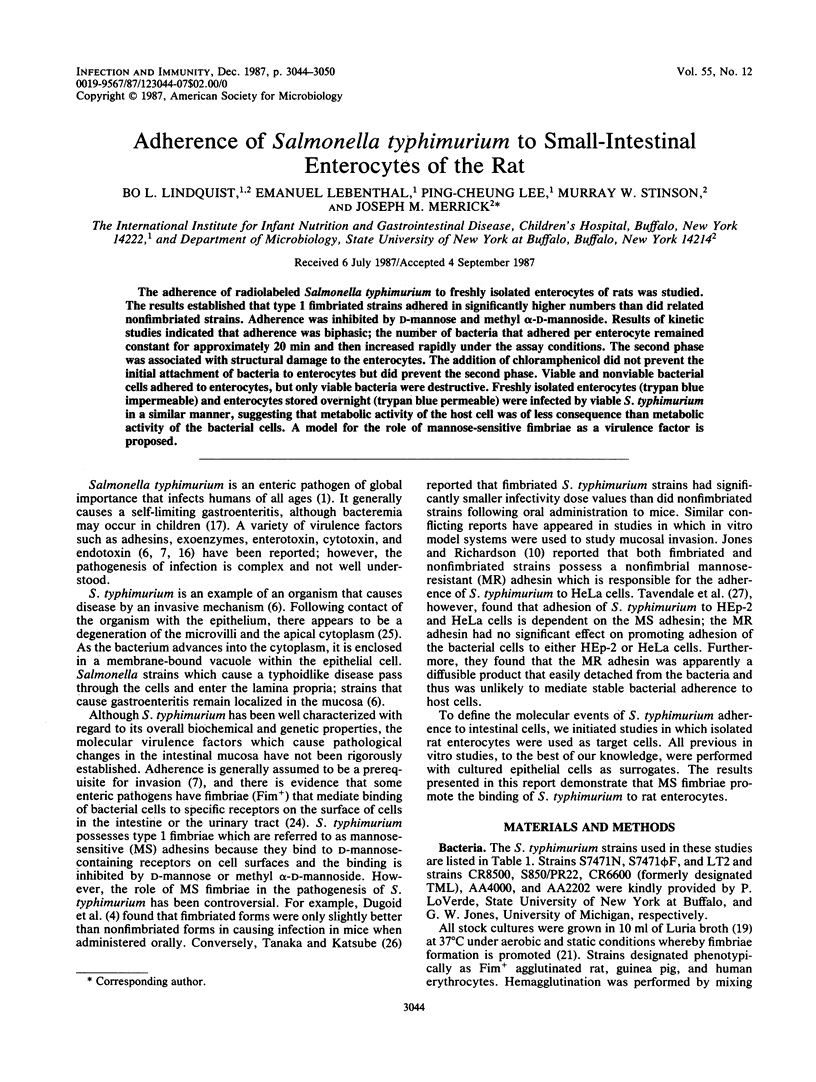
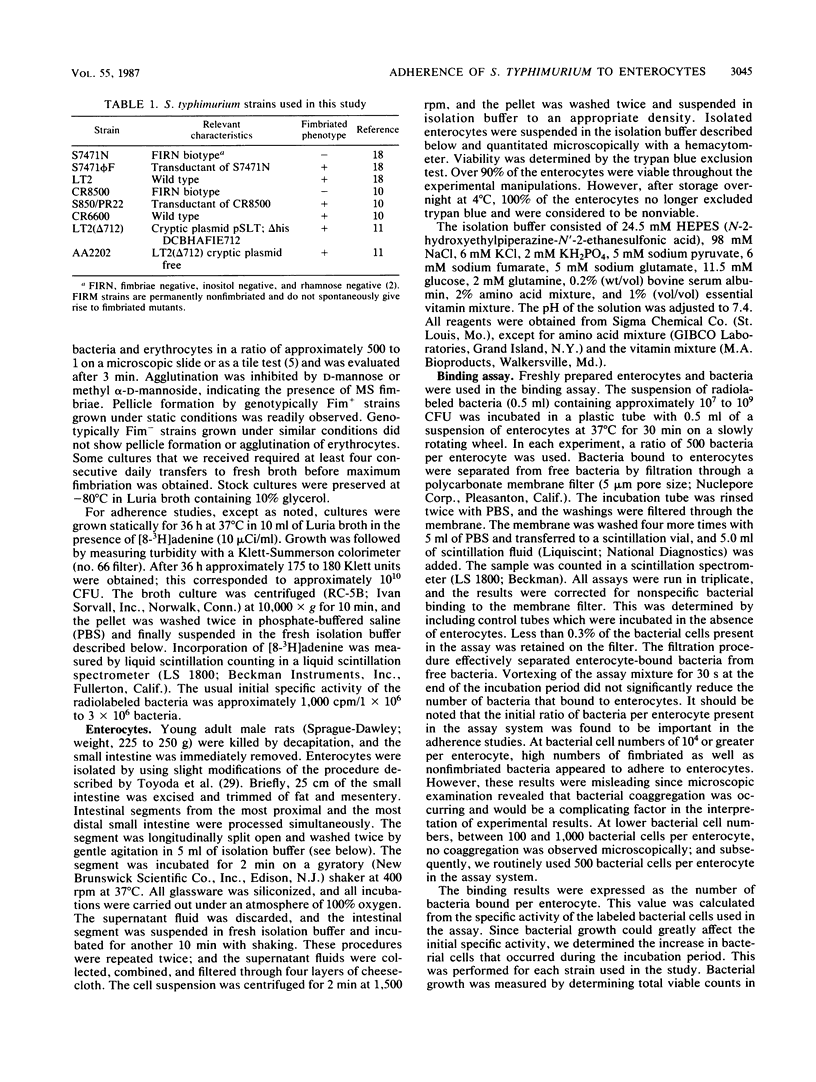
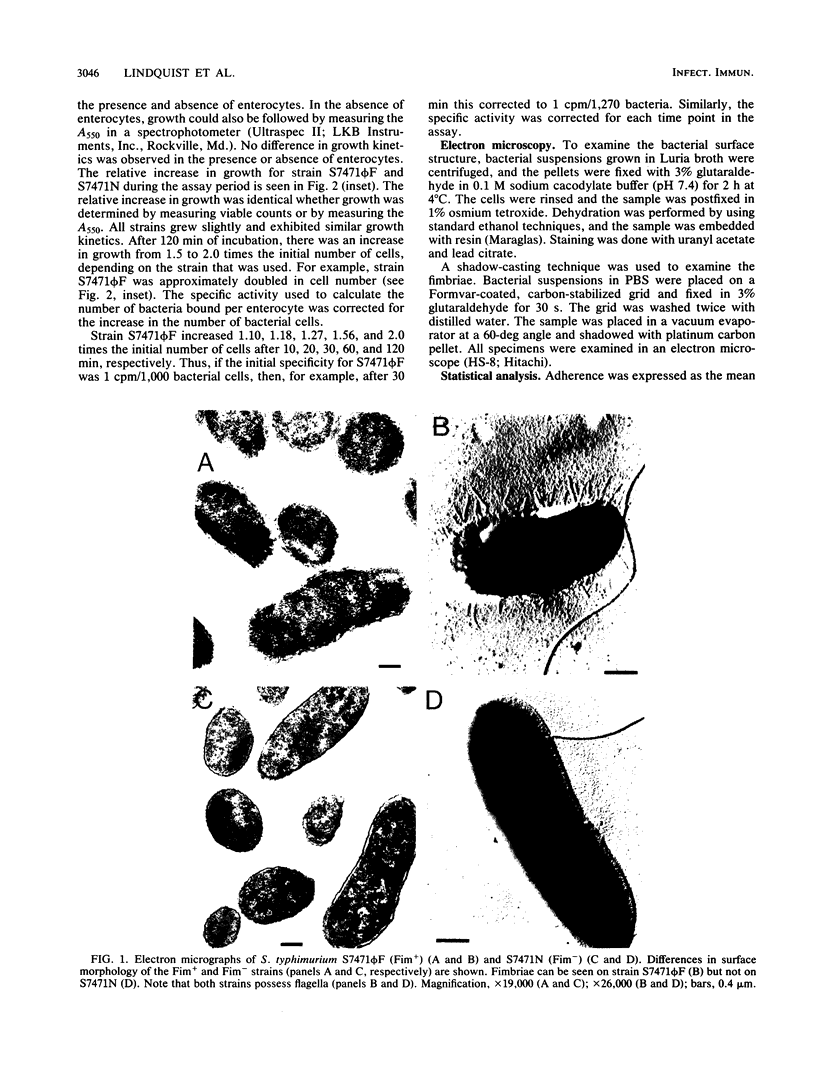
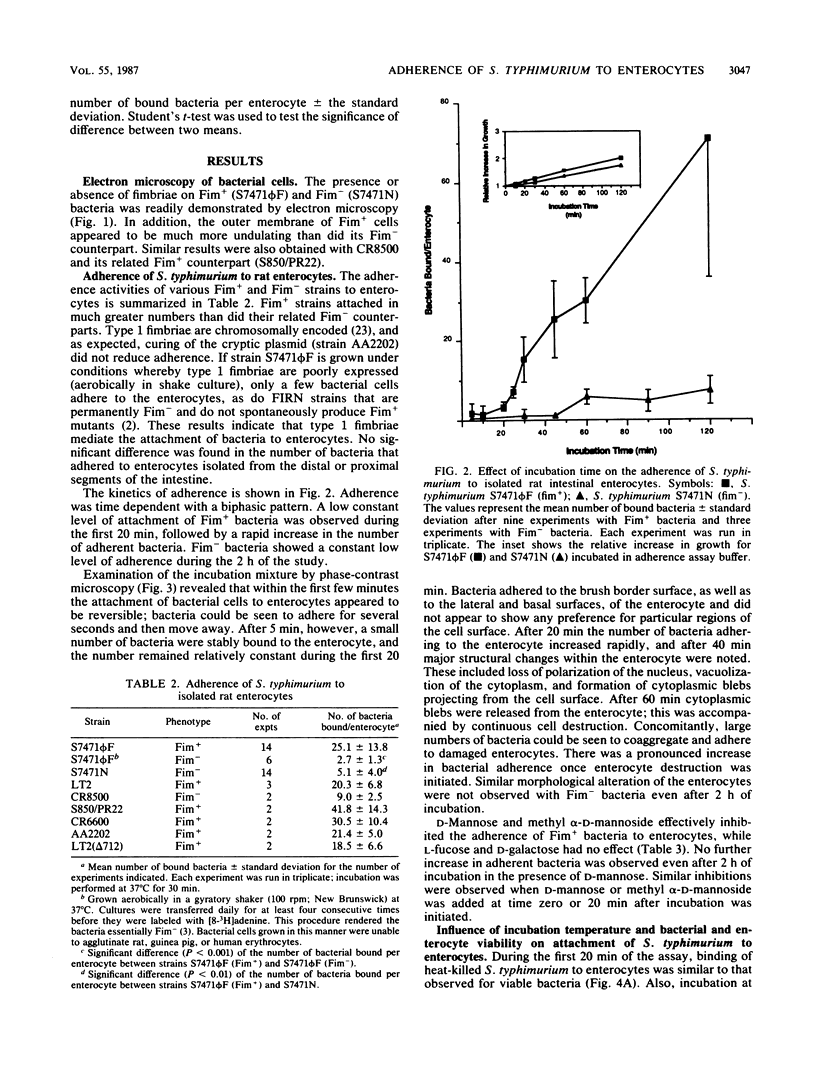
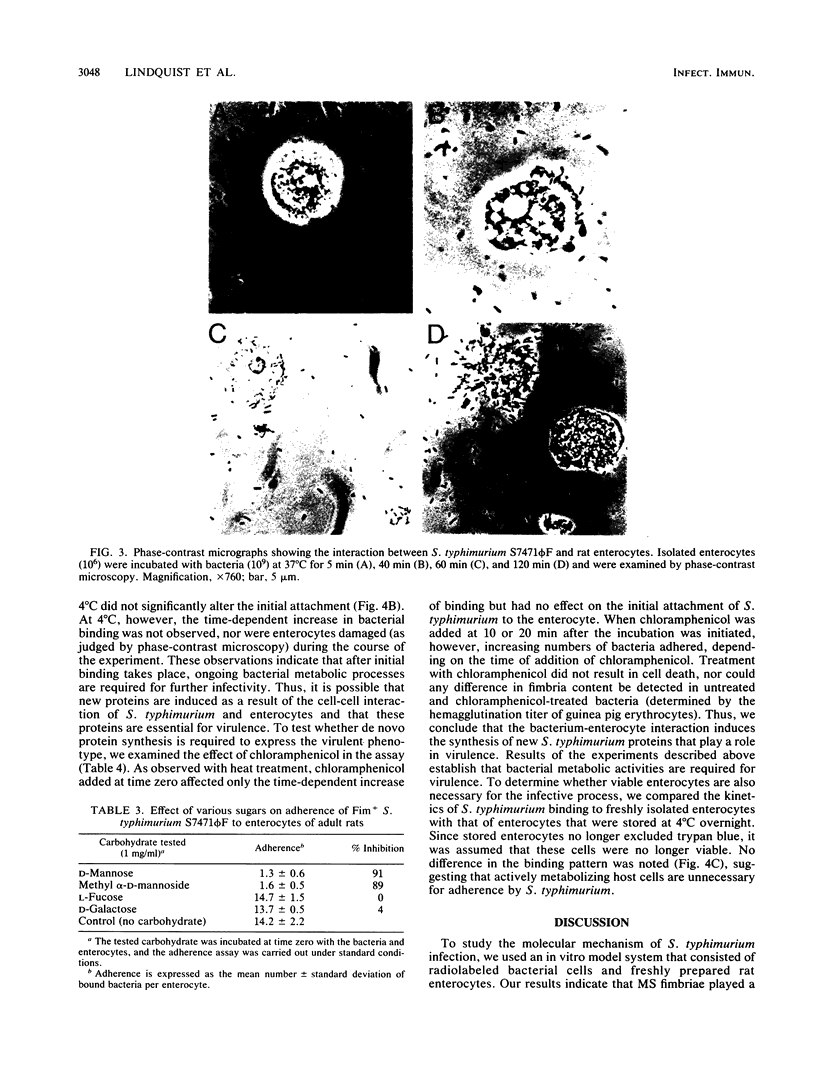
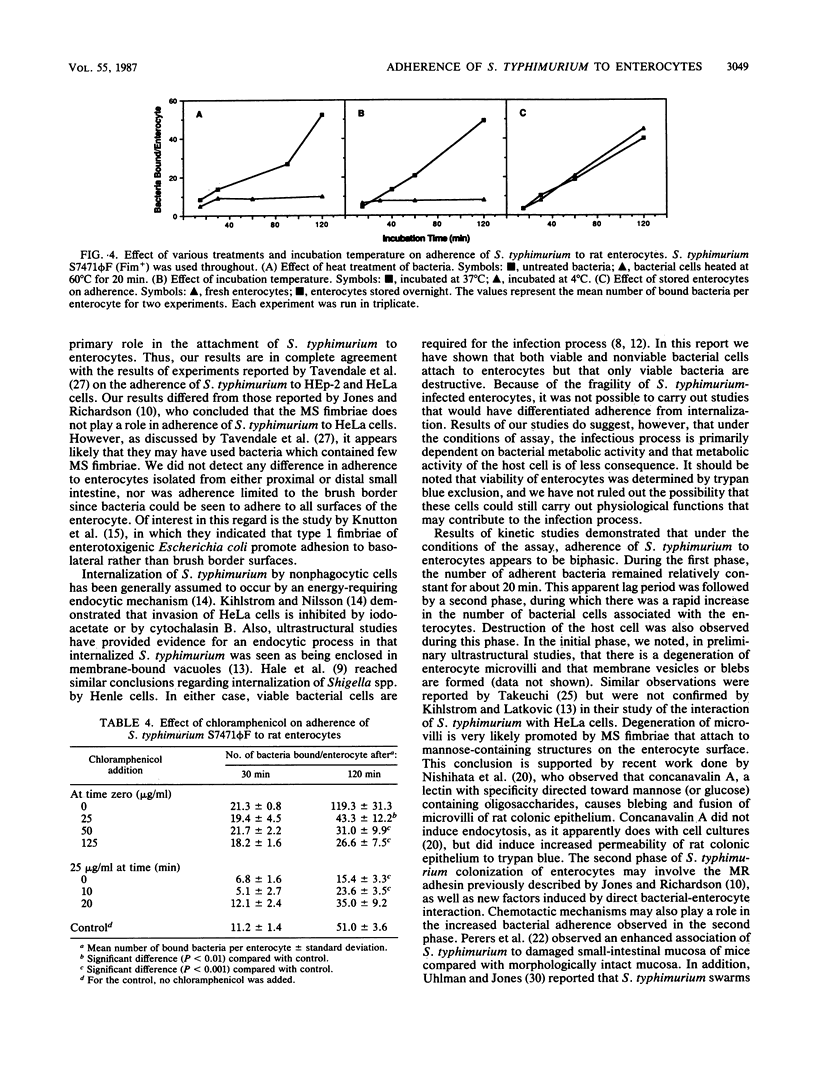
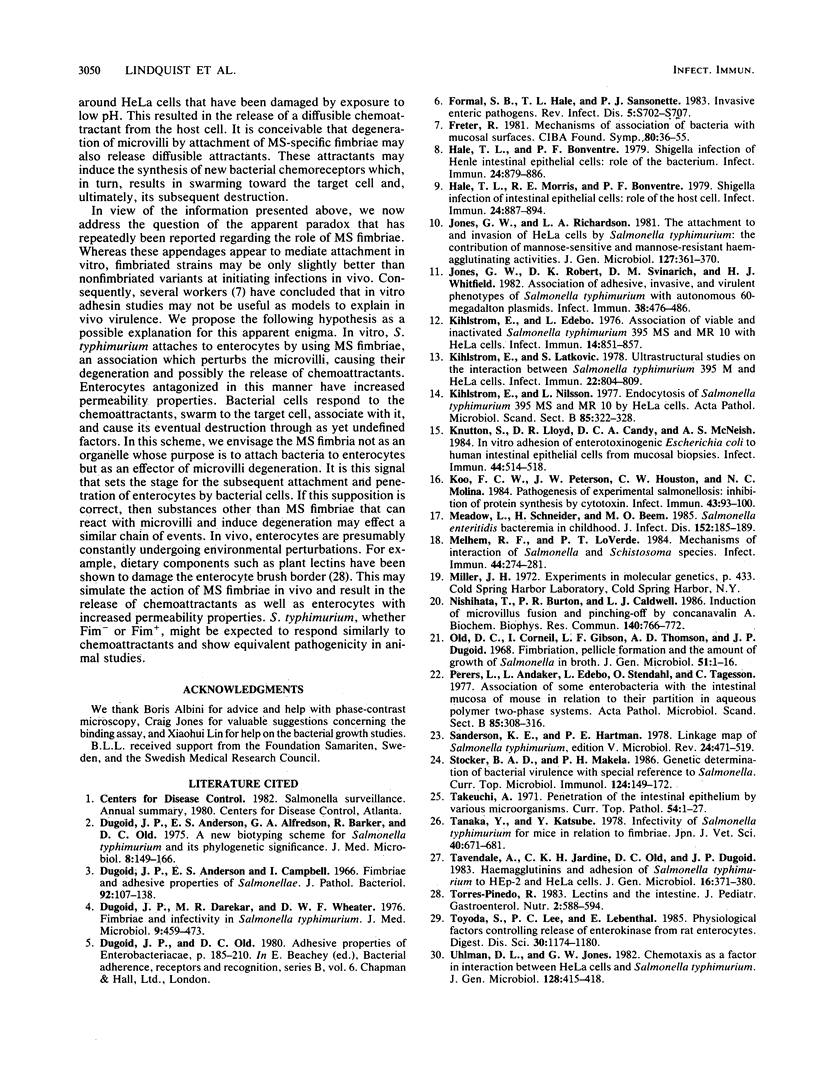
Images in this article
Selected References
These references are in PubMed. This may not be the complete list of references from this article.
- Duguid J. P., Anderson E. S., Alfredsson G. A., Barker R., Old D. C. A new biotyping scheme for Salmonella typhimurium and its phylogenetic significance. J Med Microbiol. 1975 Feb;8(1):149–166. doi: 10.1099/00222615-8-1-149. [DOI] [PubMed] [Google Scholar]
- Duguid J. P., Anderson E. S., Campbell I. Fimbriae and adhesive properties in Salmonellae. J Pathol Bacteriol. 1966 Jul;92(1):107–138. doi: 10.1002/path.1700920113. [DOI] [PubMed] [Google Scholar]
- Duguid J. P., Darekar M. R., Wheater D. W. Fimbriae and infectivity in Salmonella typhimurium. J Med Microbiol. 1976 Nov;9(4):459–473. doi: 10.1099/00222615-9-4-459. [DOI] [PubMed] [Google Scholar]
- Formal S. B., Hale T. L., Sansonetti P. J. Invasive enteric pathogens. Rev Infect Dis. 1983 Sep-Oct;5 (Suppl 4):S702–S707. doi: 10.1093/clinids/5.supplement_4.s702. [DOI] [PubMed] [Google Scholar]
- Freter R. Mechanisms of association of bacteria with mucosal surfaces. Ciba Found Symp. 1981;80:36–55. doi: 10.1002/9780470720639.ch4. [DOI] [PubMed] [Google Scholar]
- Hale T. L., Bonventre P. F. Shigella infection of Henle intestinal epithelial cells: role of the bacterium. Infect Immun. 1979 Jun;24(3):879–886. doi: 10.1128/iai.24.3.879-886.1979. [DOI] [PMC free article] [PubMed] [Google Scholar]
- Hale T. L., Morris R. E., Bonventre P. F. Shigella infection of henle intestinal epithelial cells: role of the host cell. Infect Immun. 1979 Jun;24(3):887–894. doi: 10.1128/iai.24.3.887-894.1979. [DOI] [PMC free article] [PubMed] [Google Scholar]
- Jones G. W., Rabert D. K., Svinarich D. M., Whitfield H. J. Association of adhesive, invasive, and virulent phenotypes of Salmonella typhimurium with autonomous 60-megadalton plasmids. Infect Immun. 1982 Nov;38(2):476–486. doi: 10.1128/iai.38.2.476-486.1982. [DOI] [PMC free article] [PubMed] [Google Scholar]
- Jones G. W., Richardson L. A. The attachment to, and invasion of HeLa cells by Salmonella typhimurium: the contribution of mannose-sensitive and mannose-resistant haemagglutinating activities. J Gen Microbiol. 1981 Dec;127(2):361–370. doi: 10.1099/00221287-127-2-361. [DOI] [PubMed] [Google Scholar]
- Kihlström E., Edebo L. Association of viable and inactivated Salmonella typhimurium 395 MS and MR 10 with HeLa cells. Infect Immun. 1976 Oct;14(4):851–857. doi: 10.1128/iai.14.4.851-857.1976. [DOI] [PMC free article] [PubMed] [Google Scholar]
- Kihlström E., Latkovic S. Ultrastructural studies on the interaction between Salmonella typhimurium 395 M and HeLa cells. Infect Immun. 1978 Dec;22(3):804–809. doi: 10.1128/iai.22.3.804-809.1978. [DOI] [PMC free article] [PubMed] [Google Scholar]
- Kihlström E., Nilsson L. Endocytosis of Salmonella typhimurium 395 MS and MR10 by HeLa cells. Acta Pathol Microbiol Scand B. 1977 Oct;85B(5):322–328. doi: 10.1111/j.1699-0463.1977.tb01982.x. [DOI] [PubMed] [Google Scholar]
- Knutton S., Lloyd D. R., Candy D. C., McNeish A. S. In vitro adhesion of enterotoxigenic Escherichia coli to human intestinal epithelial cells from mucosal biopsies. Infect Immun. 1984 May;44(2):514–518. doi: 10.1128/iai.44.2.514-518.1984. [DOI] [PMC free article] [PubMed] [Google Scholar]
- Koo F. C., Peterson J. W., Houston C. W., Molina N. C. Pathogenesis of experimental salmonellosis: inhibition of protein synthesis by cytotoxin. Infect Immun. 1984 Jan;43(1):93–100. doi: 10.1128/iai.43.1.93-100.1984. [DOI] [PMC free article] [PubMed] [Google Scholar]
- Meadow W. L., Schneider H., Beem M. O. Salmonella enteritidis bacteremia in childhood. J Infect Dis. 1985 Jul;152(1):185–189. doi: 10.1093/infdis/152.1.185. [DOI] [PubMed] [Google Scholar]
- Melhem R. F., LoVerde P. T. Mechanism of interaction of Salmonella and Schistosoma species. Infect Immun. 1984 May;44(2):274–281. doi: 10.1128/iai.44.2.274-281.1984. [DOI] [PMC free article] [PubMed] [Google Scholar]
- Nishihata T., Burton P. R., Caldwell L. J. Induction of microvillous fusion and pinching-off by concanavalin A. Biochem Biophys Res Commun. 1986 Oct 30;140(2):766–772. doi: 10.1016/0006-291x(86)90797-7. [DOI] [PubMed] [Google Scholar]
- Old D. C., Corneil I., Gibson L. F., Thomson A. D., Duguid J. P. Fimbriation, pellicle formation and the amount of growth of salmonellas in broth. J Gen Microbiol. 1968 Apr;51(1):1–16. doi: 10.1099/00221287-51-1-1. [DOI] [PubMed] [Google Scholar]
- Perers L., Andåker L., Edebo L., Stendahl O., Tagesson C. Association of some enterobacteria with the intestinal mucosa of mouse in relation to their partition in aqueous polymer two-phase systems. Acta Pathol Microbiol Scand B. 1977 Oct;85B(5):308–316. doi: 10.1111/j.1699-0463.1977.tb01980.x. [DOI] [PubMed] [Google Scholar]
- Sanderson K. E., Hartman P. E. Linkage map of Salmonella typhimurium, edition V. Microbiol Rev. 1978 Jun;42(2):471–519. doi: 10.1128/mr.42.2.471-519.1978. [DOI] [PMC free article] [PubMed] [Google Scholar]
- Stocker B. A., Mäkelä P. H. Genetic determination of bacterial virulence, with special reference to Salmonella. Curr Top Microbiol Immunol. 1986;124:149–172. doi: 10.1007/978-3-642-70986-9_9. [DOI] [PubMed] [Google Scholar]
- Tanaka Y., Katsube Y. Infectivity of Salmonella typhimurium for mice in relation to fimbriae. Nihon Juigaku Zasshi. 1978 Dec;40(6):671–681. doi: 10.1292/jvms1939.40.671. [DOI] [PubMed] [Google Scholar]
- Tavendale A., Jardine C. K., Old D. C., Duguid J. P. Haemagglutinins and adhesion of Salmonella typhimurium to HEp2 and HeLa cells. J Med Microbiol. 1983 Aug;16(3):371–380. doi: 10.1099/00222615-16-3-371. [DOI] [PubMed] [Google Scholar]
- Torres-Pinedo R. Lectins and the intestine. J Pediatr Gastroenterol Nutr. 1983 Nov;2(4):588–594. doi: 10.1097/00005176-198311000-00003. [DOI] [PubMed] [Google Scholar]
- Toyoda S., Lee P. C., Lebenthal E. Physiological factors controlling release of enterokinase from rat enterocytes. Dig Dis Sci. 1985 Dec;30(12):1174–1180. doi: 10.1007/BF01314053. [DOI] [PubMed] [Google Scholar]
- Uhlman D. L., Jones G. W. Chemotaxis as a factor in interactions between HeLa cells and Salmonella typhimurium. J Gen Microbiol. 1982 Feb;128(2):415–418. doi: 10.1099/00221287-128-2-415. [DOI] [PubMed] [Google Scholar]



